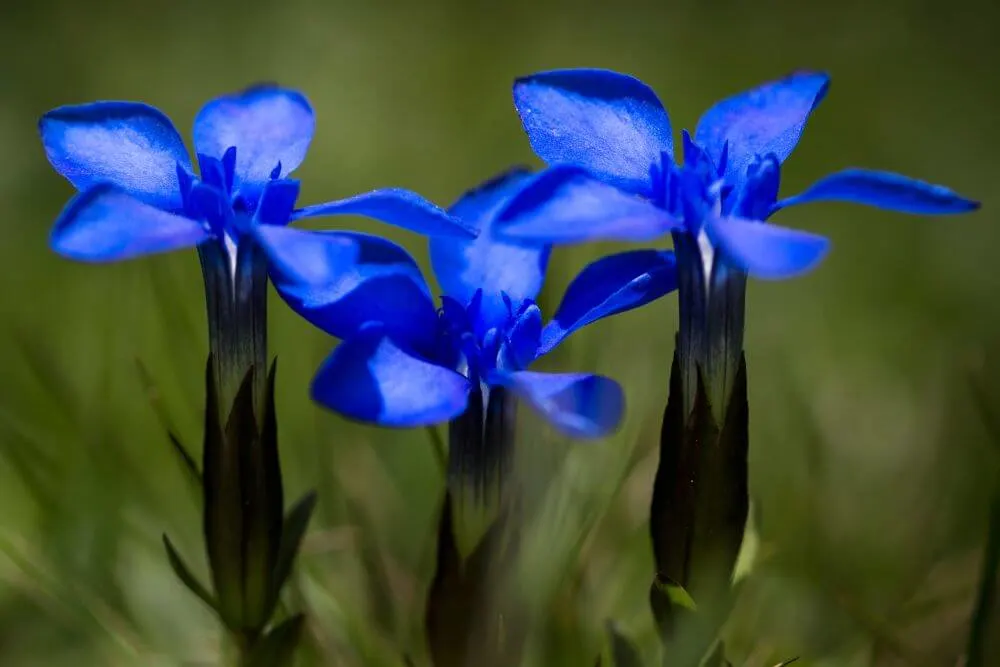
Table of Contents
- 1 The Flora of Ireland
- 2 What is the national flower of Ireland?
- 3 National Flower of Northern Ireland
- 4 Flowers associated with Ireland
- 5 14 Native Flowers of Ireland and Meanings (with Irish Plant Names)
- 6 Early Spring Flowers that grow in Ireland
- 7 Late Spring Flowers of Ireland
- 8 Native Irish flowers of Summer
- 9 Late flowering plant
- 10 Native Plants of Ireland – In Flower All Year Round
- 11 Invasive Plants in Ireland
- 12 FAQ
The Flora of Ireland
Ireland is home to many beautiful flowering species and a range of unique habitats.
Given the fact that Ireland is an island, it is not that surprising that the number of native flowers Ireland has is less than that of its nearby European neighbors.
There are thought to be about 850 native Irish plants and 28 native trees. These are plants that have over thousands of years adapted to the Irish climate and soil conditions.
In addition to the native Irish plants and flowers, many other plant species have been both accidentally or intentionally introduced (such as ornamental garden plants) over the time.
This article will introduce you to some of Ireland’s most beautiful native, wild Irish flowers, the habitats that these common Irish flowers grow in and some of the threats that they now face.
Enjoy the flowers of Ireland images and maybe even learn a bit of Irish as the Irish flower names for these plants are included too!
What is the national flower of Ireland?
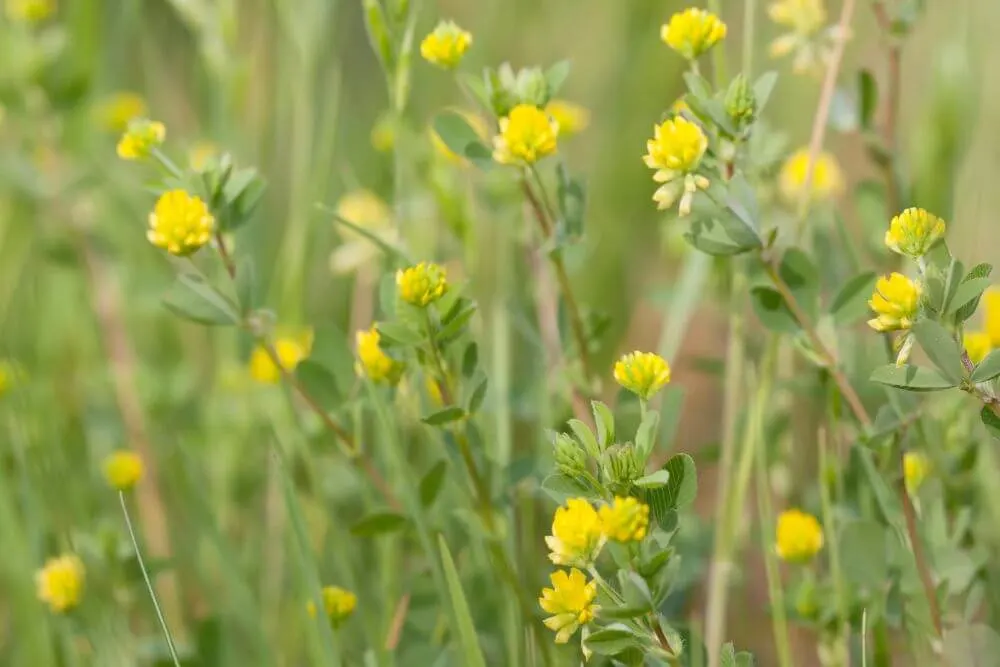
The flower of the shamrock, which is most commonly identified as the clover species Trifolium dubium, or Trifolium repens, is the national flower of Ireland. While one usually tends to think of only the green leaves of a shamrock, it also has flowers.
In Ireland, “shamrock” is most often used to refer to the three leaf clover or Trifolium species, Trifolium dubium, or Trifolium repens. The word “shamrock” itself, comes from the Irish seamair óg, which means “young clover”.
The Irish Shamrock Plant
The Irish themselves are undecided as to which plant is the “true shamrock”. One study from 1988 undertaken by E. Charels Nelson of the National Botanical Gardens in Dublin, found that 46% of the samples of “real shamrock” sent in by the Irish public was Trifolium dubium or Yellow Clover. Other samples of Irish shamrock submitted by the public included White Clover (Trifolium repens), Black Medick (Medicago lupulina), Wood Sorrel (genus Oxalis) and Red Clover (Trifolium pratense).
This would make the yellow flower of Trifolium dubium the most likely candidate for the shamrock flower, and in turn, Ireland’s national flower. (An alternative version of Ireland’s flower would be the whitish heads of Trifolium repens.)
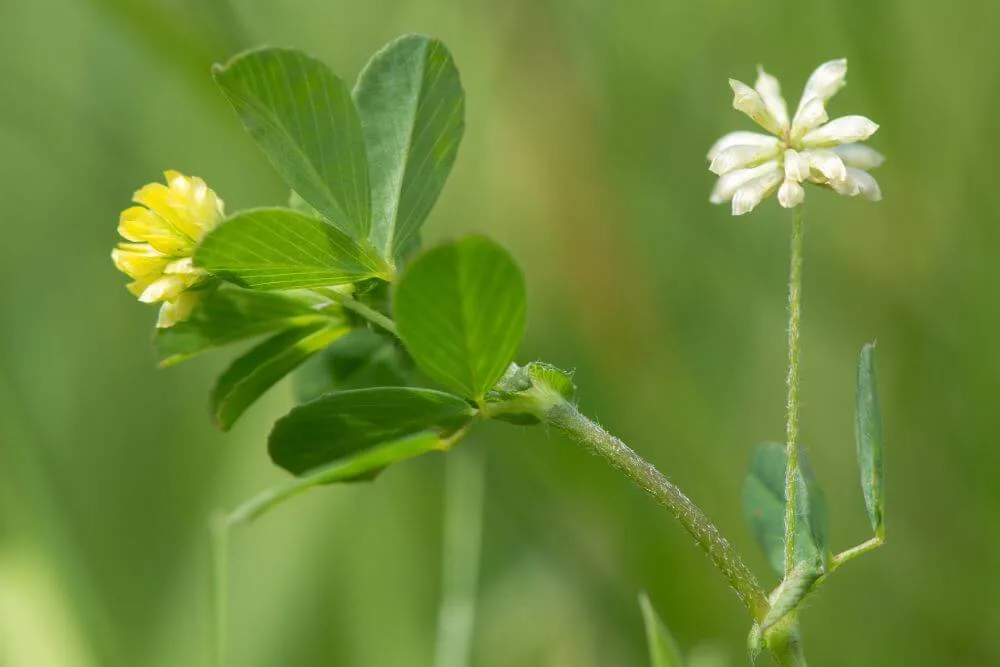
History of the Shamrock
The Shamrock has been associated with the Emerald Isle for a long time. One of Ireland’s most famous legends says that Saint Patrick himself used the three-leaf clover to explain the story of the Holy Trinity.*
While it may be hard to decipher fact from fiction with regards to the patron saint of Ireland, what is thought to be true is that Shamrock has been used to adorn Irish people’s hats and clothes to mark St. Patrick’s Day (which is on March 17th), since around the 17th century.
From around the 18th century, the Shamrock has been used as a symbol of Ireland and its popularity continued to grow as the Irish emigrated and brought their culture to the four corners of the world.
Today, the Shamrock is probably the most widely used of all the national symbols of Ireland and features as part of the emblems of many different organizations such as Tourism Ireland (which covers tourism throughout Ireland, both north and south of the border), to the Irish Farmers Association (Republic of Ireland).
*The number three has always had strong significance in Celtic culture with the existence of triple deities, such as the Morrigan and the Goddess Brigit, as well as Celtic symbols, such as the triskele and triquetra.
Celtic art has also been greatly inspired by animal and plant motifs. Celtic flower and animal patterns can be seen in some of the details of the ornate borders of the illustrated manuscripts, such as the Book of Durrow and the Book of Kells.
National Flower of Northern Ireland
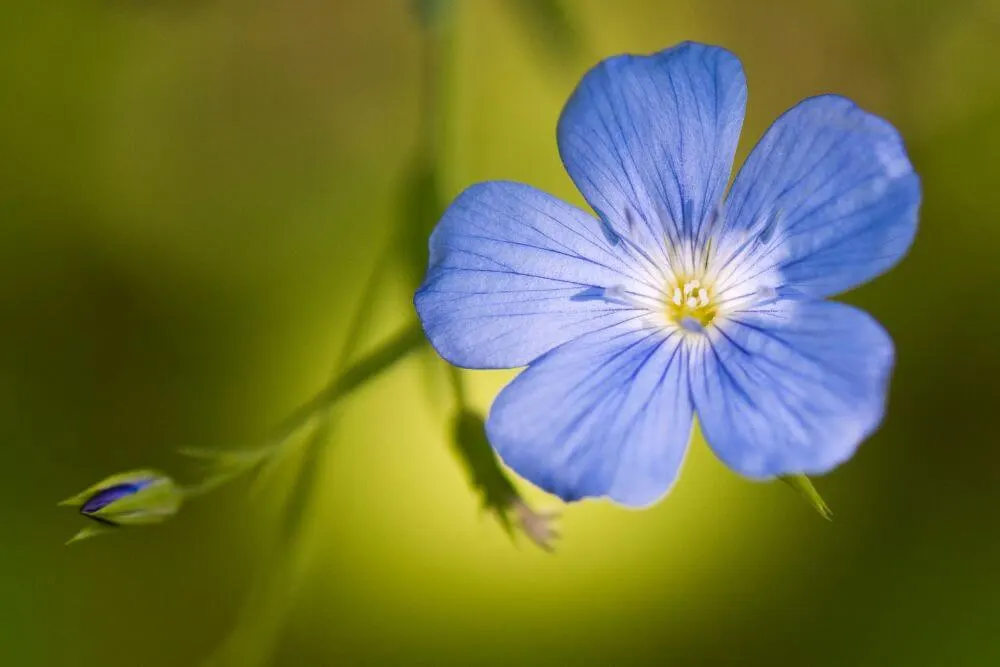
The Flax flower (Linum usitatissimum) is often used as the national flower of Northern Ireland and is found on the Northern Ireland Assembly emblem.
Linen, which is made from the fiber of Flax, is one of the oldest fabrics and has a long tradition of production and usage throughout the island of Ireland.
Northern Ireland, however, has a particularly strong association with linen as it became a major production hub from about the late 17th century. This was largely as a result of the new knowledge and techniques that Huguenots fleeing persecution in France brought with them when they settled in the area.
The Shamrock is also used as a national symbol in Northern Ireland. It is sometimes shown alongside the other national symbols of the United Kingdom, including the Thistle of Scotland, the Rose of England and the leek of Wales.
One of the symbols found on the badge of the Northern Ireland Police Service is the Shamrock.
Flowers associated with Ireland
It is a little ironic, but some of the flowers that people most associate with Ireland, are not actually flowers that are indigenious to Ireland.
Fuchsia
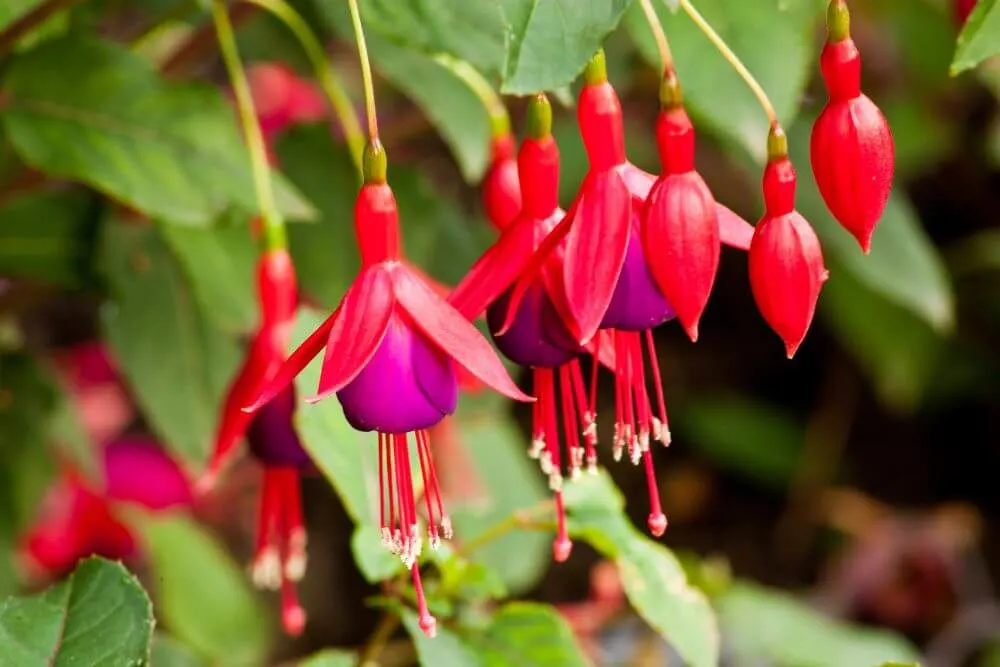
Fuschia (Fuchsia magellanica) is a plant native to South America and was first introduced into Ireland as an ornamental garden plant, which was commonly planted as hedging. The Irish name for the red teardrop flowers is deora Dé, which means “tears of God”.
The mild climate near the coast, particularly in and around West Cork and the Dingle Peninsula is very suited to this deciduous shrub. During the summer months up until about October, the view of unmissable, vibrant red and purple flowers dotting the hedges that line the narrow roads is quite a sight!
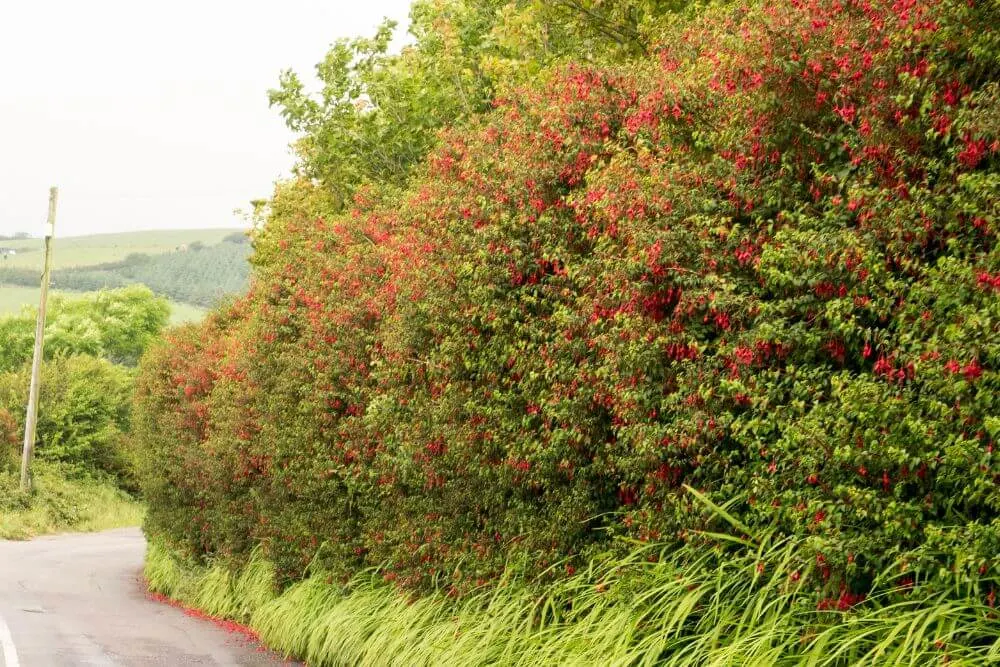
The flowers are often used as a design in jewelry, pottery and other handmade items from the west of Ireland. The widespread abundance and popularity of Fuchsia has led to it becoming the Irish flower symbol logo for “A taste of West Cork”, which is used to identify local goods and services from West Cork.
Due to its popularity, Fuchsia is sometimes unofficially referred to as the Irish national flower.
Montbretia
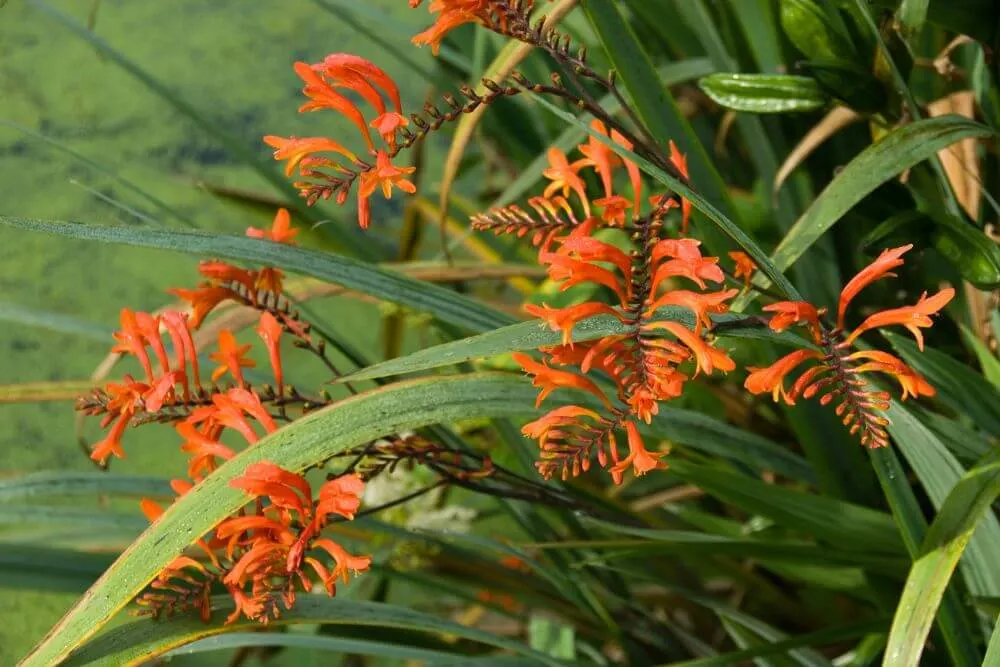
Fuchsia is often seen growing near the red-orange flowers of Montbretia (Crocosmia × crocosmiiflora), which are also commonly seen along roadsides and occasionally riverbanks in late summer and autumn. This hybrid cross is thought to have originated in France towards the end of the 19th century and was introduced to gardens in Ireland soon afterwards.
Easter Lily
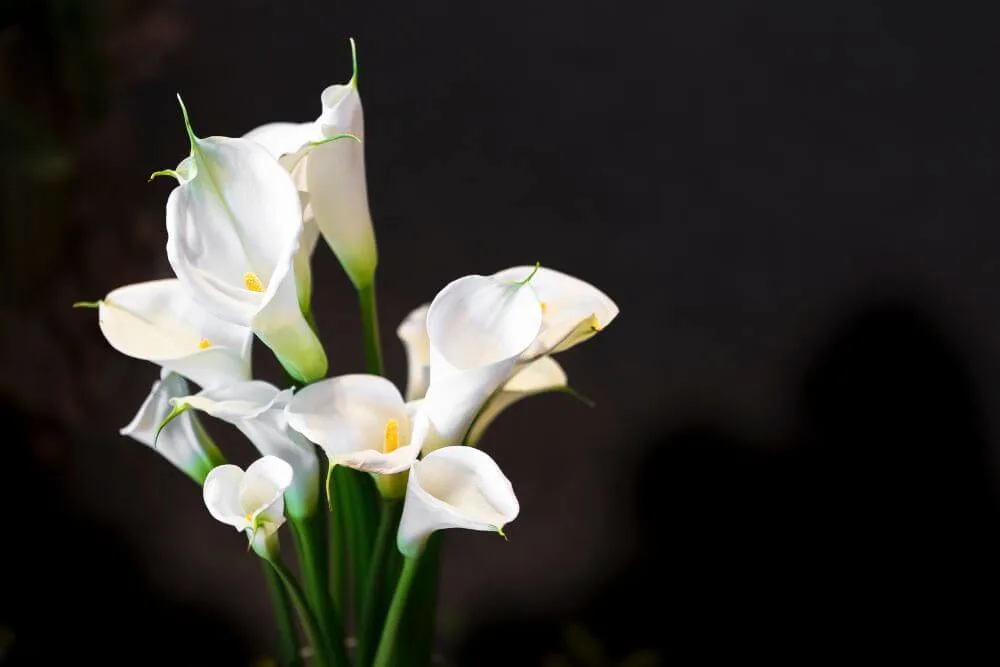
The Easter Lily is most well known as the Calla Lily and is native to southern Africa. These ornamental flowers became a popular symbol of remembrance to those who died as part of the 1916 Easter Rising in Ireland.
In 1926, Cumann na mBan (which translates to the “The Women’s Council”, a female group who supported the Irish Republican Army during the War of Independence) started selling these Easter Lilies as badges outside churches on Easter Sunday to raise funds for the families who had lost loved ones during the Rising of 1916.
The green, white and orange colors of the Irish flag are present in these flowers, making them a suitable choice for Irish nationalists.
The association of Easter Lilies with purity and radiance also makes flower arrangements with these lilies a frequent choice of Irish flowers for funerals.
It is worth noting that the Calla Lily is toxic due to the insoluble crystals of calcium oxalate that are found in the plant, so it is best to keep small children and pets at their distance.
14 Native Flowers of Ireland and Meanings (with Irish Plant Names)
The following plants will give you a good overview of the names of Irish flowers and where to find them.
To make it a little easier to follow, the Irish wild flowers have been divided into the time of year when you are most likely to spot each flowering species.
Early Spring Flowers that grow in Ireland
Wood Anemone
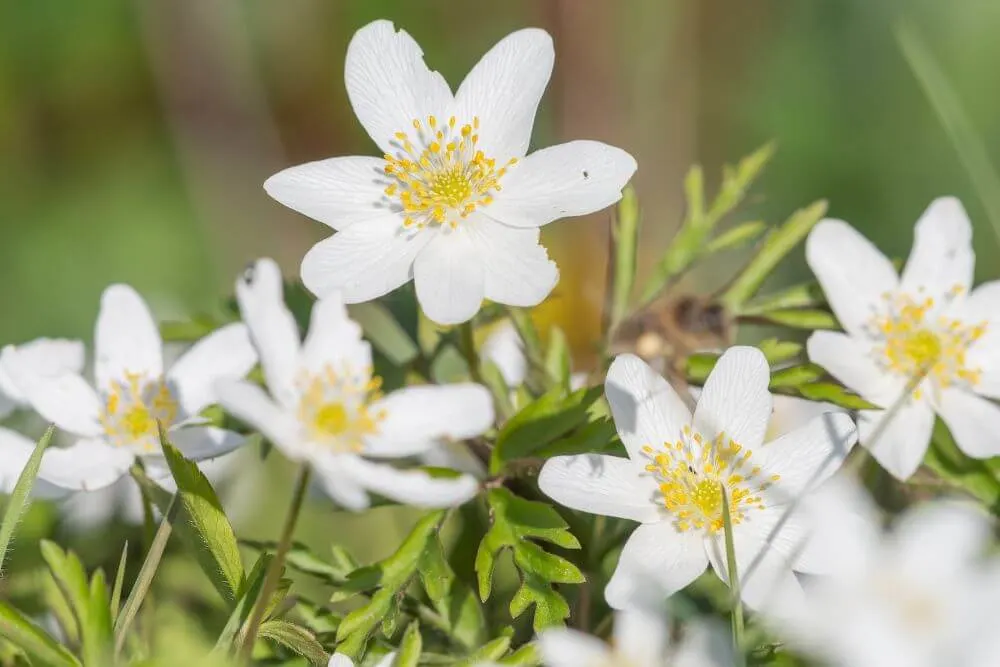
Irish Name: Lus na gaoithe
Latin name: Anemone nemorosa
Family: Ranunculaceae
The delicate white Irish flowers of the Wood Anemone are found often in carpets in semi-shaded areas of woodlands, alongside roads and streams across Ireland during spring time (roughly from late February or March). Occasionally, the flowers are tinged with a faint pink or purple color.
In Irish, their name is Lus na gaoithe (Plant of the wind). This name perfectly reflects the flexible nature of the stem, which continually tilts and bends with the slightest little gust of wind. The plant is also occasionally called “Windflower”.
Usually the flowers do not face upwards, but hang slightly to one side. Each flower contains somewhere between 5 and 10 sepals (similar to petals, but leaf-like).
The sap of the Wood Anemone can cause skin irritation and there are also toxic compounds that are poisonous to humans.
Lesser Celandine
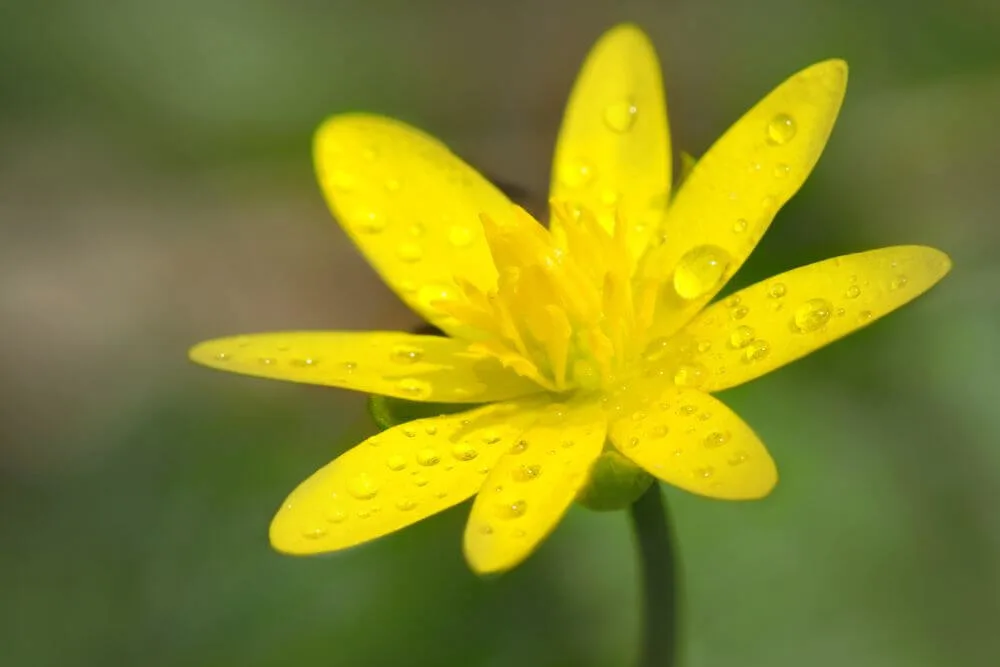
Irish Name: Grán arcáin
Latin name: Ficaria verna (Ranunculus ficaria)
Family: Ranunculaceae
Many of the early plants that in Ireland flower in springtime are yellow. The Lesser Celandine is one such early spring flower that provides much needed nectar for early pollinators. The golden-yellow flowers contain about 8-10 petals and are sensitive to light. Flowers close during dull days, as well as at night.
It is best to look for these flowers in damper areas such as in wooded areas, but also along rivers, at the base of hedges and along roadsides. The heart shaped leaves of the plant are a good identifier and are usually hairless.
Flowering can begin as early as December and continue through spring until about May.
Recently this species has been placed in its own genus (Ficaria).
It is also thought to have been used as a herbal treatment for piles (hence the name Pileworth), as well as scurvy.
Primrose
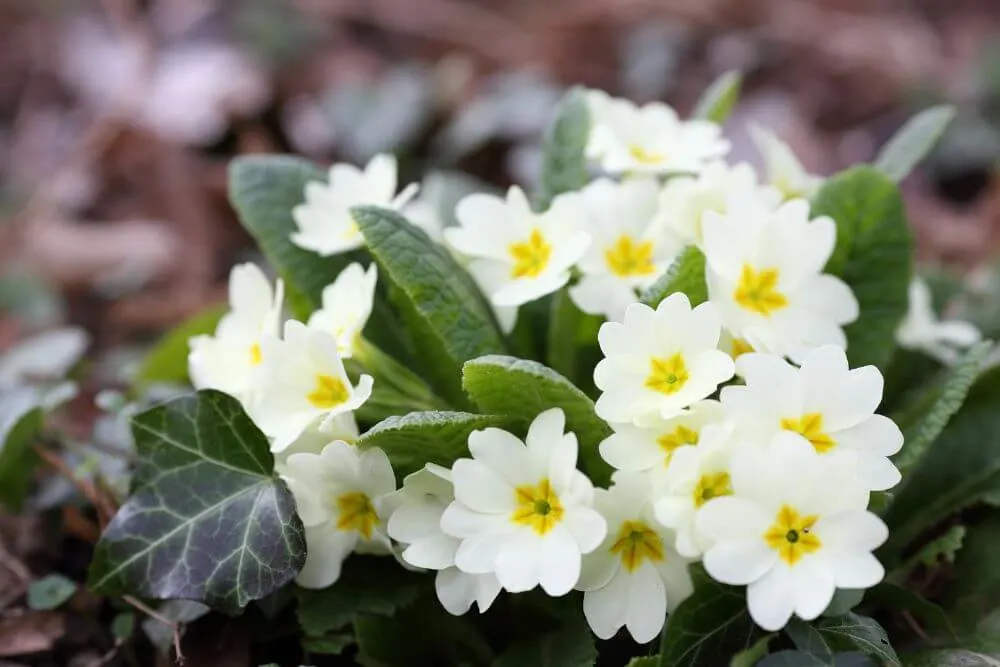
Irish Name: Sabhaircín
Latin name: Primula vulgaris
Family: Primulaceae
The Primrose is a perennial plant, native to Ireland that is most usually a creamy yellow color, but has also been found in other colors, such as a pure white and pink.
This ground hugging plant has quite prominent wrinkled leaves that spread out in the form of a rosette from its base.
Under the right conditions, most notably in a protected, sheltered area, Primroses can also flower as early as December. Damp soil that is slightly acidic tends to suit the primrose best. They are often found in wooded areas and along roadsides.
The Primrose is somewhat similar to a Cowslip (Primua veris). One of the most obvious differences is that Primroses have a single stem for each flower, whereas the Cowslip has multiple flowers coming from a single stem.
Late Spring Flowers of Ireland
Bluebell
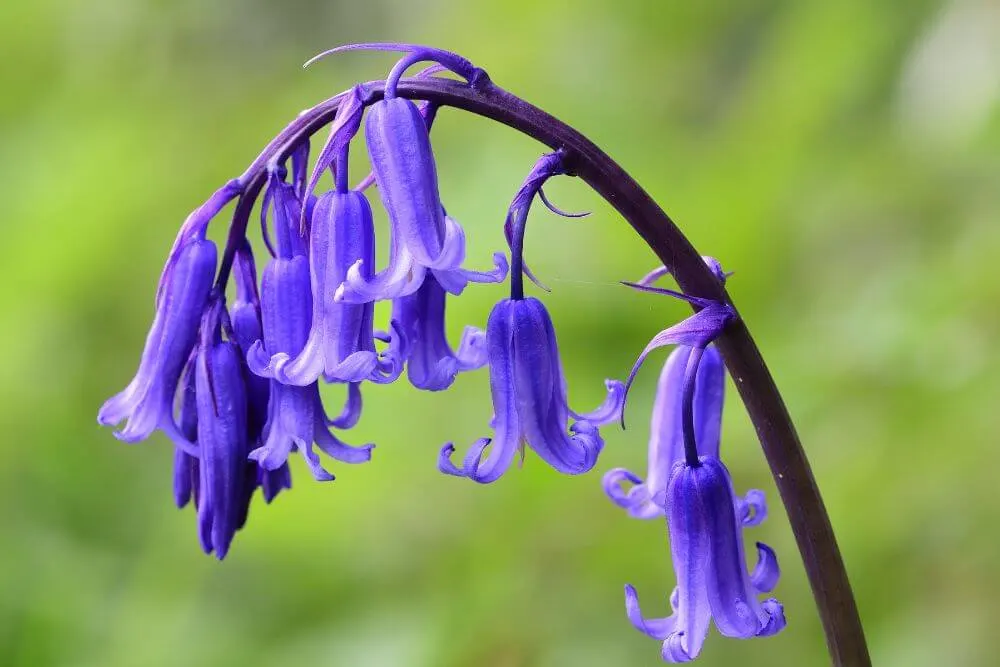
Irish Name: Coinnle coora
Latin name: Hyacinthoides non-scripta
Family: Lilaceae
Bluebells are most often found in woodlands, before the tree canopy has closed. This plant in Ireland flowers around April and May.
The sight of a carpet of pretty Bluebells is really a spectacular one to behold. Quite often other flowering plants such as Primrose, Wood Anemone, Dog Violet and Lesser Celandine are also part of this carpet.
The native Bluebell Hyacinthoides non-scripta is very similar to the Spanish Bluebell (Hyacinthoides hispanica) which seems to be becoming more widespread in Ireland. The tubular flowers of the native Bluebell curl backwards, are darker in color and have a distinctive scent when compared with the Spanish Bluebells.
Narrower leaves are also found on the native plant (roughly about 1.5 cm wide).
To make matters a little bit more confusing, hybrid varieties of both the native Bluebell and the Spanish Bluebell now also exist. This video from the Irish National Wildlife Trust explains the differences quite clearly.
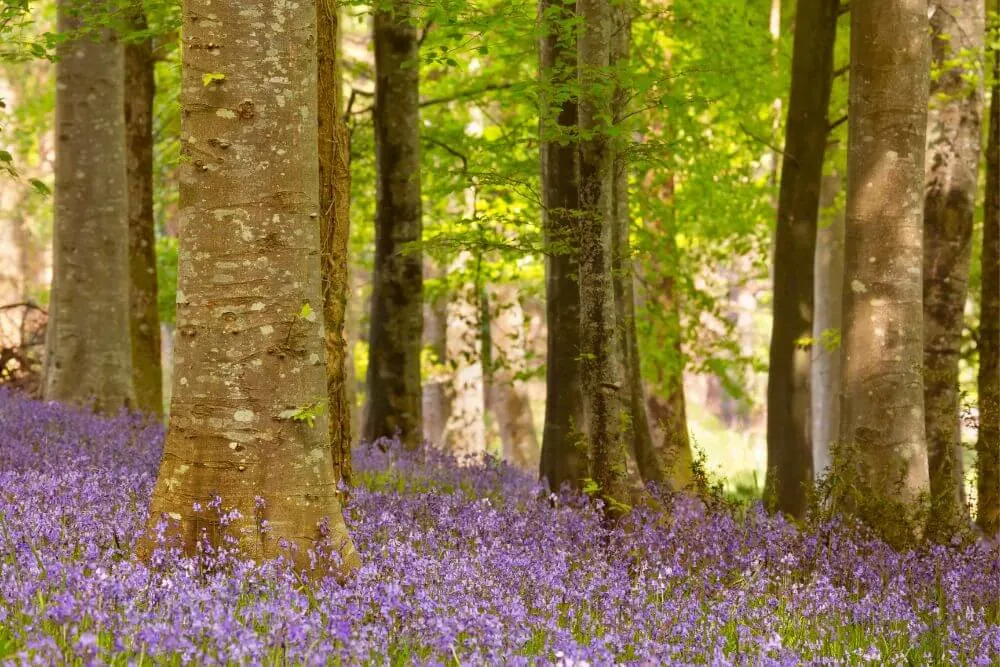
There are many bluebell flower meanings and associations especially with magic. According to folklore, Bluebell woods are often enchanted with fairy folk.
Fun fact: Bluebells are poisonous, but have been used for some practical purposes through the ages, such as the gluey substance made from the sap that was used in the process of bookbinding and to prevent damage by insects.
Spring Gentian
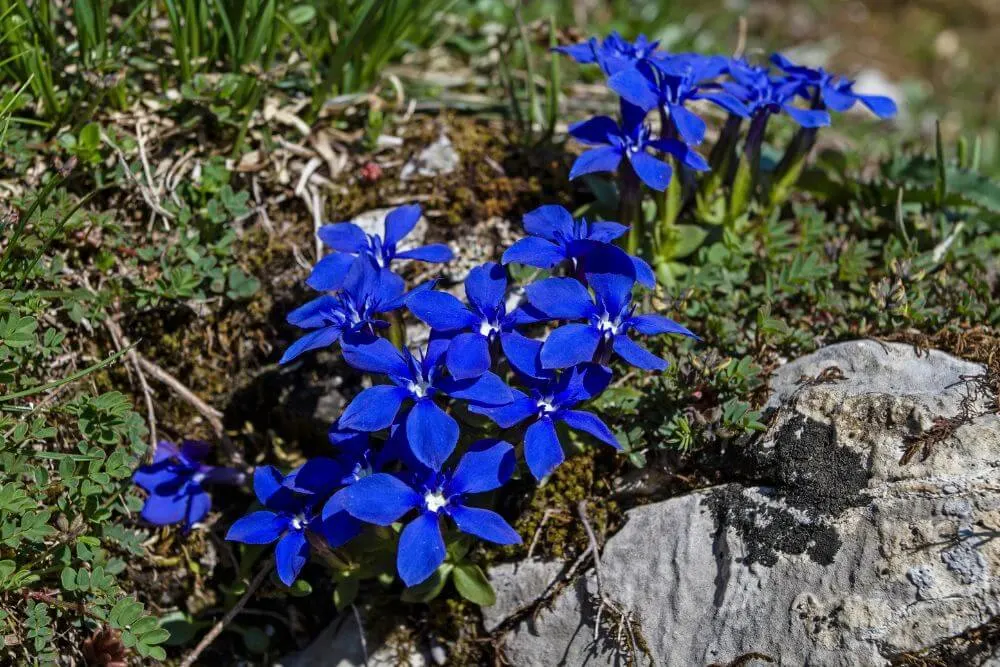
Irish Name: Ceadharlach Bealtaine
Latin Name: Gentiana verna
Family: Gentianaceae
One of the most electrifying floral sights in Ireland is the vivid blue of the Spring Gentian. This beautiful flower is found primarily in the Burren, County Clare and also in County Galway and County Mayo. It has become one of the best known of all blue Irish flowers and is probably the most famous of all the many species of plants in the Burren.
This Alpine plant is almost exclusively found at higher elevations (higher than ca. 460 m), but in the Burren, thanks to its unusual geology, unique climate and grazing management, it is found close to sea level in the calcareous grasslands and limestone pavements.
The trumpet-shaped flowers come into bloom between April and June. Each flower has five bright blue petal lobes, with a white central tube. Occasionally, these gentians are also found in white.
This species is listed in the Red Data List of Vascular Plants as being near threatened. If you are lucky enough to catch a glimpse, please take care not to damage the plants in any way.
Bog Rosemary
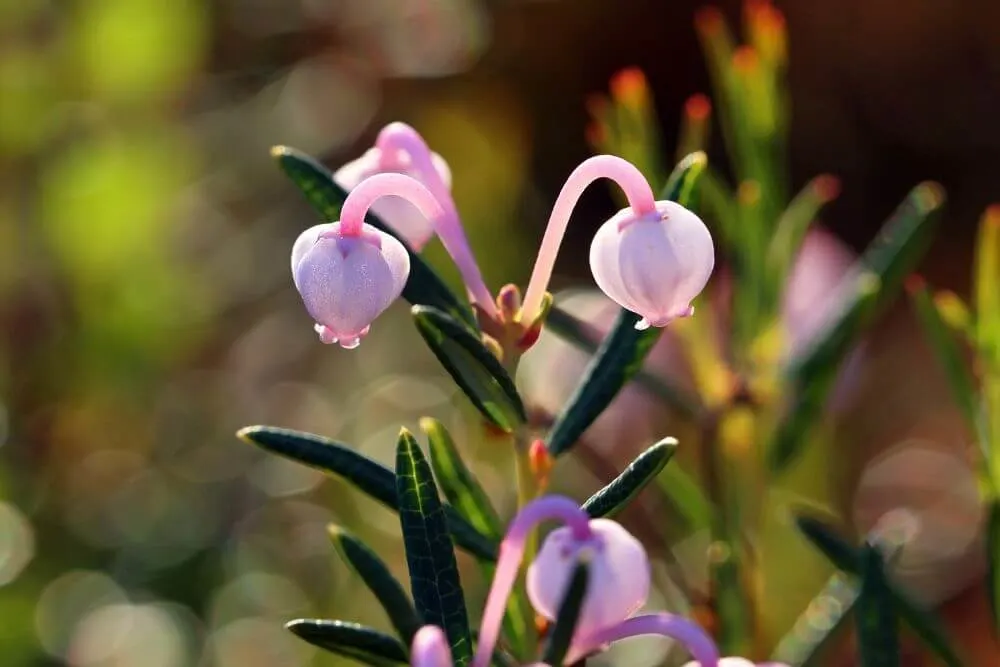
Irish Name: Lus na móinte
Latin Name: Andromeda polifolia
Family: Ericaceae
During May and June, the small, round pink flowers of Bog Rosemary can be occasionally seen in the lowland raised bogs, mostly in and around the midlands of Ireland, with some scattered locations in Northern Ireland as well.
During early flowering, the bell-shaped flowers are a deeper pink color and tend to lighten to light pink or almost white by the end of June. The small shrub rarely grows to heights of more than about 40cm (ca. 1.3ft)
This is one of the rare Irish wildflowers that is protected due to its declining numbers. It is quite sensitive to changes in bogs, particularly in relation to bog water levels.
Over the centuries, destruction of the raised bogs on which this plant grows has greatly impacted its population. Ongoing habitat loss through drainage and agriculture, as well as further exploitation of the raised bogs as a fuel and compost source in the form of peat continues to threaten the future of this plant.
While the name Bog Rosemary, might lead you to believe that it is closely related to the herb, this is not the case. Bog Rosemary is a poisonous plant that should not be ingested.
Spring Squill
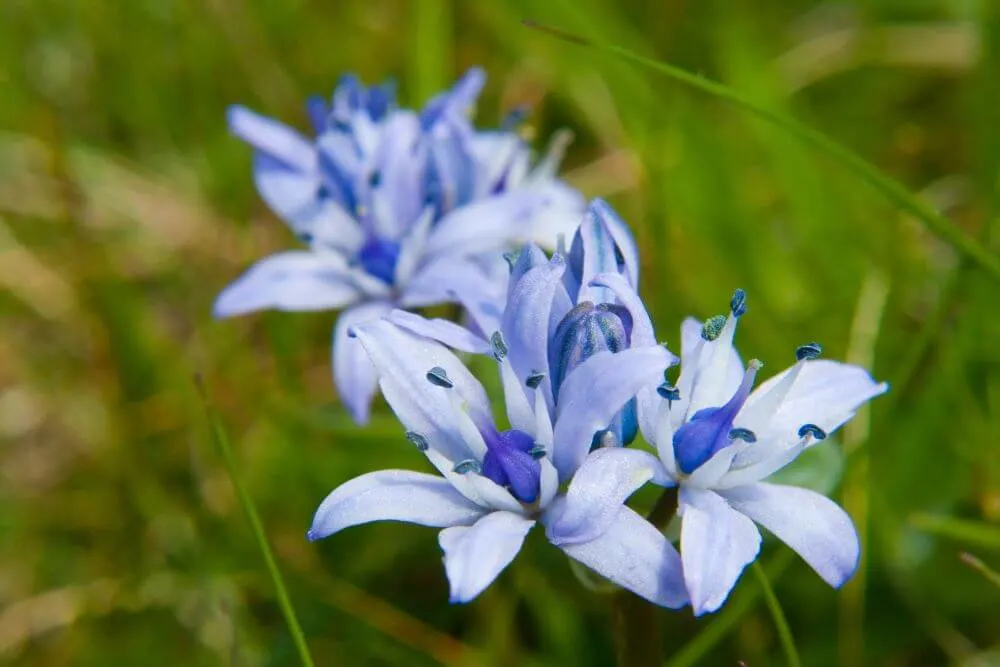
Irish Name: Sciolla earraigh
Latin Name: Scilla verna
Family: Asparagaceae
The Spring Squill is a delicate plant typically found in areas near the coast.
It is well adapted to sea spray and can be often found on dry cliff tops, rocky slopes and coastal grassy areas along the eastern coast of Ireland. Previous records have shown that it was once more abundant.
This perennial bulb flowers between April and May and produces blue-lilac, pointed flowers. The flowers are star shaped with six petals and produce black seeds.
Spring Squill plants rarely grow to heights of more than about 20cm (ca. 8”).
Yellow Rattle
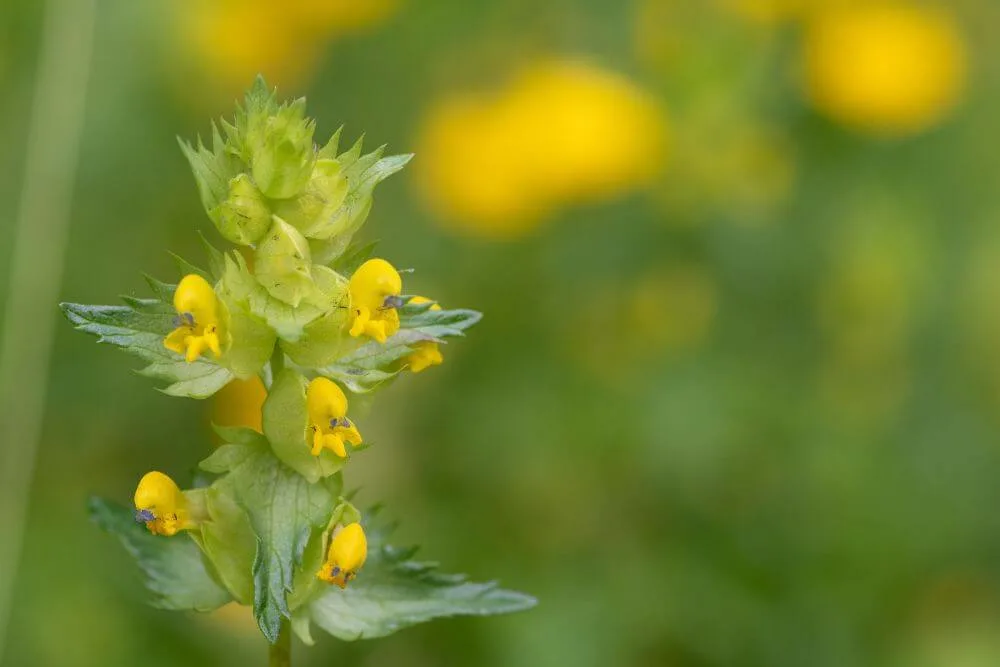
Irish Name: Gliográn
Latin name: Rhinanthus minor
Family: Scrophulariaceae
The Yellow Rattle is a meadow flower that appears in semi-natural grassland and dune areas from around May to the end of August. It has yellow flowers that are found on leafy spikes. The stem of the plant is typically black and the leaves are narrow, with a serrated edge.
As the name suggests, this plant does rattle when the wildflower seeds are present inside the little bladder-like capsules, which occurs towards the end of summer.
This plant is sometimes known as the “Meadow Maker” as it is semi-parasitic and can absorb nutrients from nearby plants. When these Irish wildflower seeds are sown into grass swards, it weakens the dominant grasses and enables other wildflowers to grow.
Native Irish flowers of Summer
Devils Bit Scabious
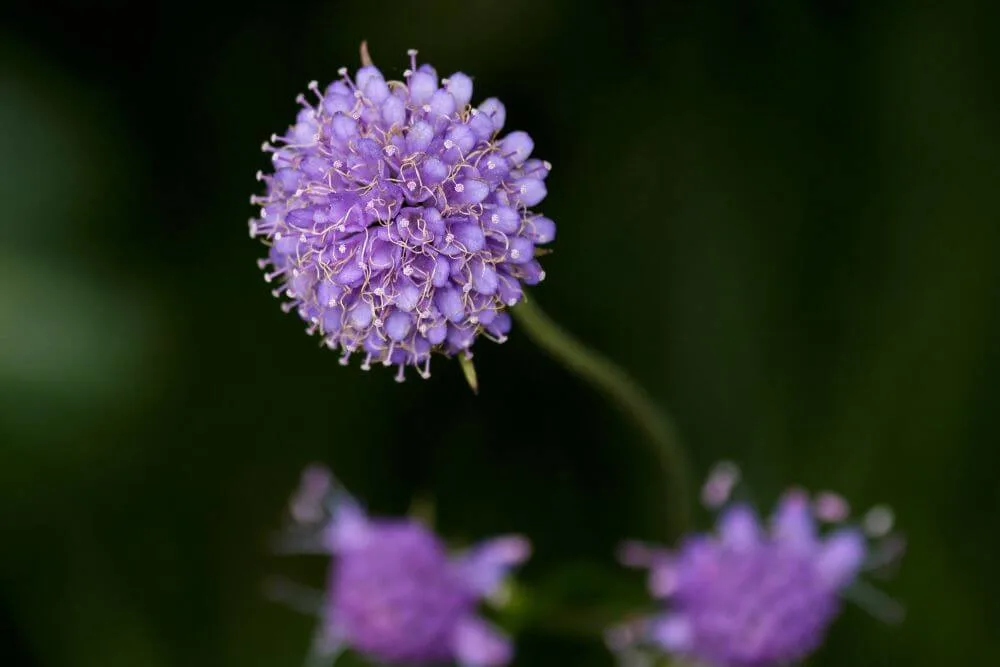
Irish Name: Odhrach bhallach
Latin name: Succisa pratensis
Family: Dipsacaceae
From June to October the blue violet heads of the Devil’s Bit Scabious can be found scattered across a wide variety of different habitat types. It is possible to find this plant growing in a hedgerow, or pasture and also in a bog. Although it can be abundant in certain areas, it is not as widespread as it once was in Ireland.
Multiple little flowers (each with four petals) are compactly arranged in the rounded head of this plant. Most of the smooth, oval leaves are located close to the ground and the flowers are held aloft on tall stems (ca. 1m or 3ft).
As well as being an important source of nectar for insects late in the summer, this plant is the main source of food for the protected Marsh Fritillary Butterfly (Euphydryas aurinia). This butterfly is one of the few butterflies in Ireland that is legally protected under the European Union Habitats and Species Directive (Annex II).
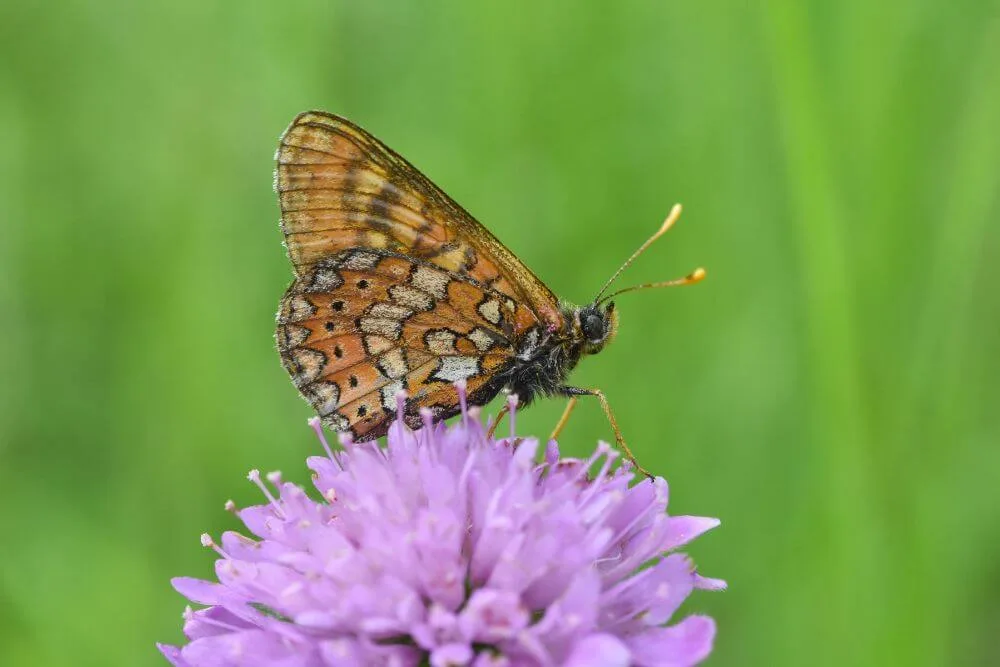
Here is a fun fact about this species: The unusual name for this plant comes from its short root. In comparison to the height of the plant, the roots are quite short and it is said that the devil bit off the roots of the plant.
It is also thought that this plant was used as a herbal cure for skin ailments, such as scabies, hence the inclusion of scabious in its name.
It is possible to use the flowers of this plant to create a blue dye.
Marsh Cinquefoil
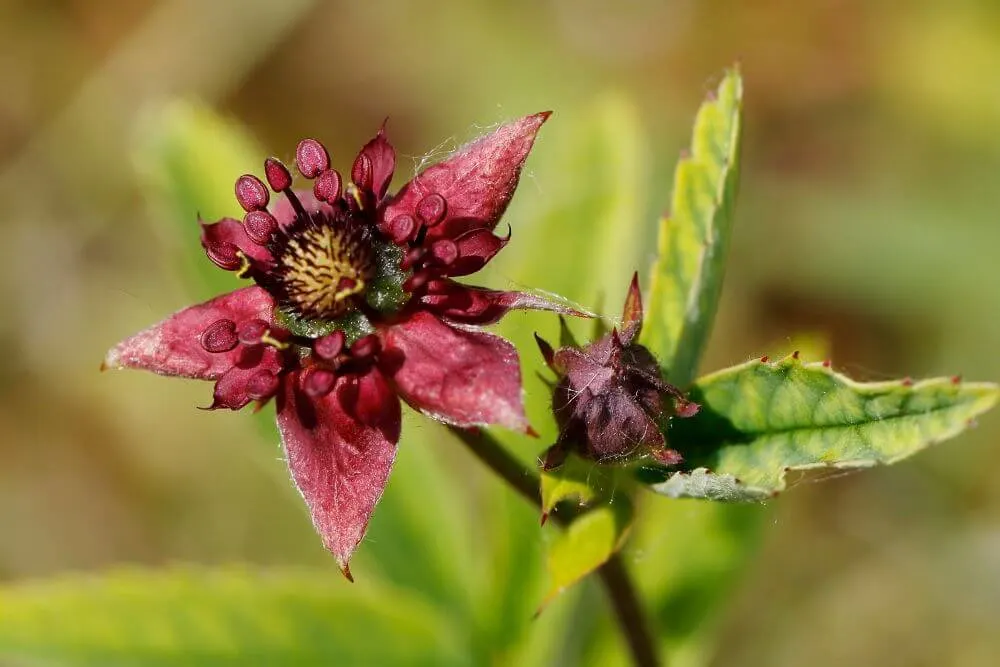
Irish Name: Cnó léana
Latin Name: Potentilla palustris
Family: Rosaceae
Between the months of May and July, the unusual plum colored flowers of the Marsh Cinquefoil can be seen in damp areas such as bogs, marshes, wet pools and wet grasslands.
Star-shaped flowers are not a very common sight in the environment where these plants grow. Each flower has five large sepals (similar to petals, but leaf-like) and are usually between 2-2.5 cm (0.7-0.9”) in diameter.
Bees and flies are regular visitors to these flowers due to its plentiful nectar.
The leaves are narrow and the tips of the leaf teeth are red in color. This perennial plant can grow to about 35cm (ca. 14”).
Another name for this plant is Bog Strawberry or Marsh Strawberry, as the fruit of this plant resembles that of a strawberry.
Due to land drainage, habitat destruction, this native species is declining in number, especially in the south of Ireland.
Honeysuckle
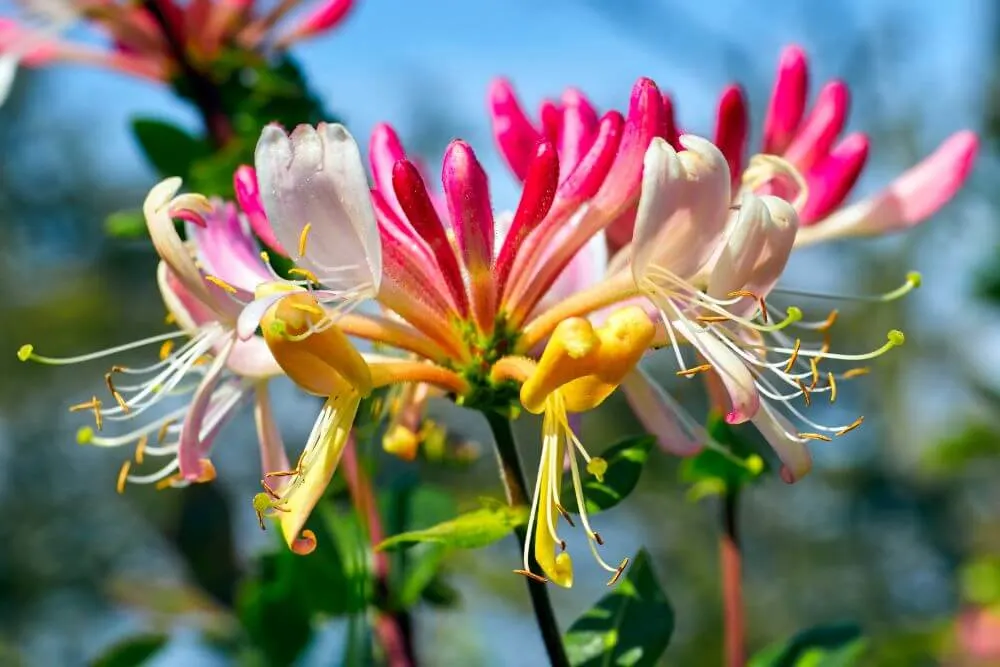
Irish Name: Táthfhéithleann
Latin name: Lonicera periclymenum
Family: Caprifoliaceae
Honeysuckle, which is also known as Woodbine, is a deciduous climbing shrub often found in hedgerows
The tubular flowers which open with a large upper and small lower lip, undergo a color transformation from pink when unopened, to white when opened and yellow when pollinated.
Compact clusters of shiny, poisonous red berries that appear to be semi-transparent appear later in the year after pollination.
Honeysuckle has a very fragrant smell, which attracts bees and other insects during the day. During the late evening and night, the fragrance is typically stronger in order to attract the moths that take over the night time pollination shift!
Late flowering plant
Ivy
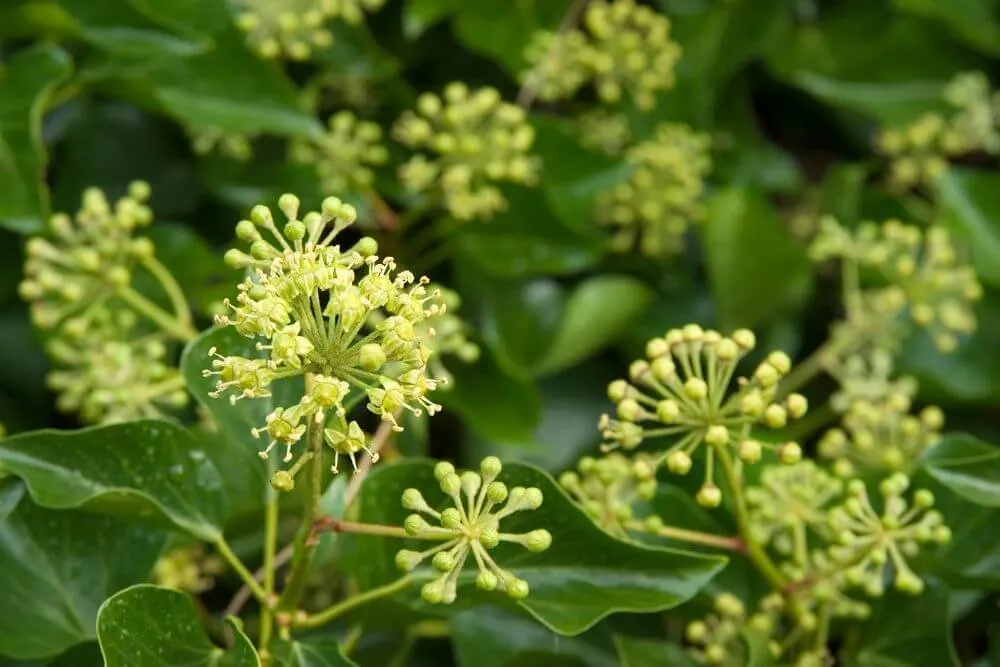
Irish Name: Eidhneán
Latin Name: Hedera helix
Family: Araliaceae
One of the plants that is abundant, and has somewhat of a bad reputation for “strangling” plants is Ivy. This is an old misconception, as in the vast majority of cases, the Ivy is not causing major damage.
Ivy is part of the natural ecosystem in Ireland and plays a crucial role in supporting biodiversity here.
In fact, Ivy is a very important plant for pollinators as it is one of the few plants to flower late in the year in Ireland (November and December). Not only does it provide for pollinators at a time of the year where typically food is scarce, but its berries are also an important source of food for birds and other animals during the winter months.
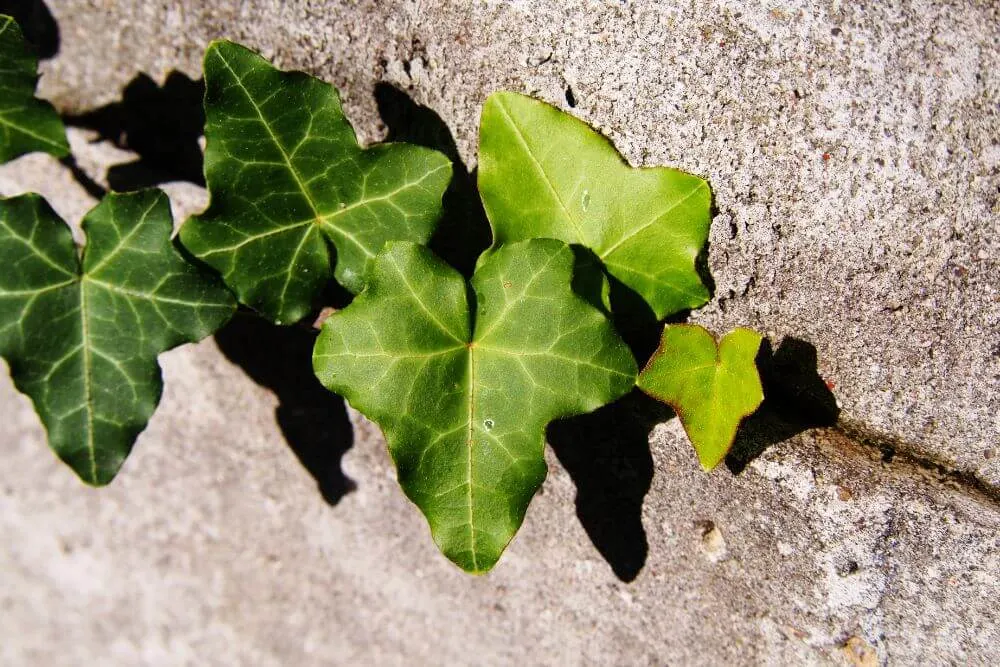
There is another type of Ivy, called Atlantic Ivy (Latin name Hedera hibernica, that is slightly different from common Ivy. It is found in Ireland, Scotland and Portugal.
Differences between the two types of Ivy are limited. The leaves of Hedera hibernica are slightly larger and may fall off in winter if there is a severe frost. It is also thought to have a sweeter smell than the common Ivy, Hedera helix.
Native Plants of Ireland – In Flower All Year Round
European Gorse
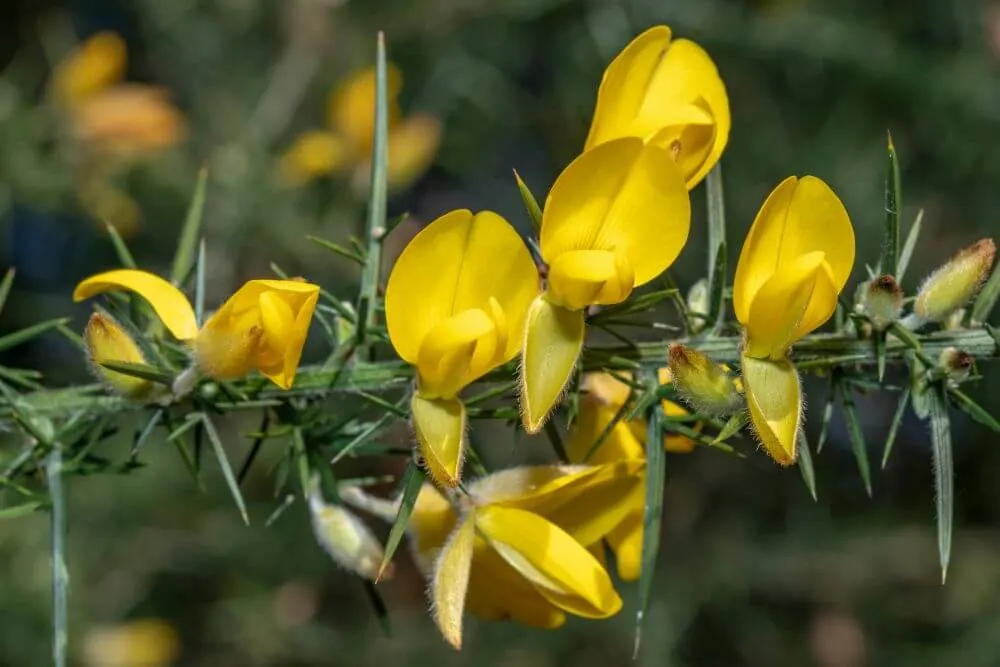
Irish Name: Aiteann gallda
Latin Name: Ulex europaeus
Family: Fabaceae
Gorse is one of the plants that can be found flowering all year round in Ireland, although the peak flowering time is usually around April. It is typically found growing in slightly acidic soil conditions in grasslands, at the edge of woods, hedgerows and roadsides.
This spiny shrub with bright yellow flowers is easy to spot on the landscape.
Gorse, which is also sometimes known as furze or whin, can grow to about 2 m in height and has strong thorns instead of leaves. It is a member of the pea or Fabaceae family, which can be seen by the shape of the two-lipped flowers.
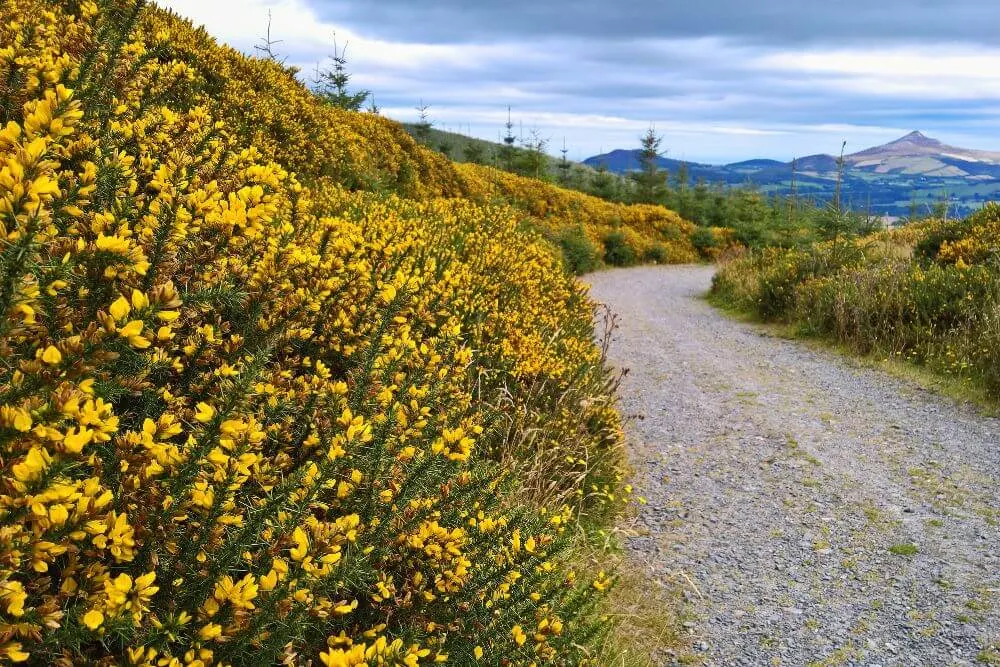
One of the easiest ways to identify this type of gorse is by the fragrant smell of its flowers that resembles coconut. The other type of gorse that grows in Ireland, western or autumn gorse (Ulex gallii), which flowers from July to September and is usually smaller than Ulex europaeus.
Daisy
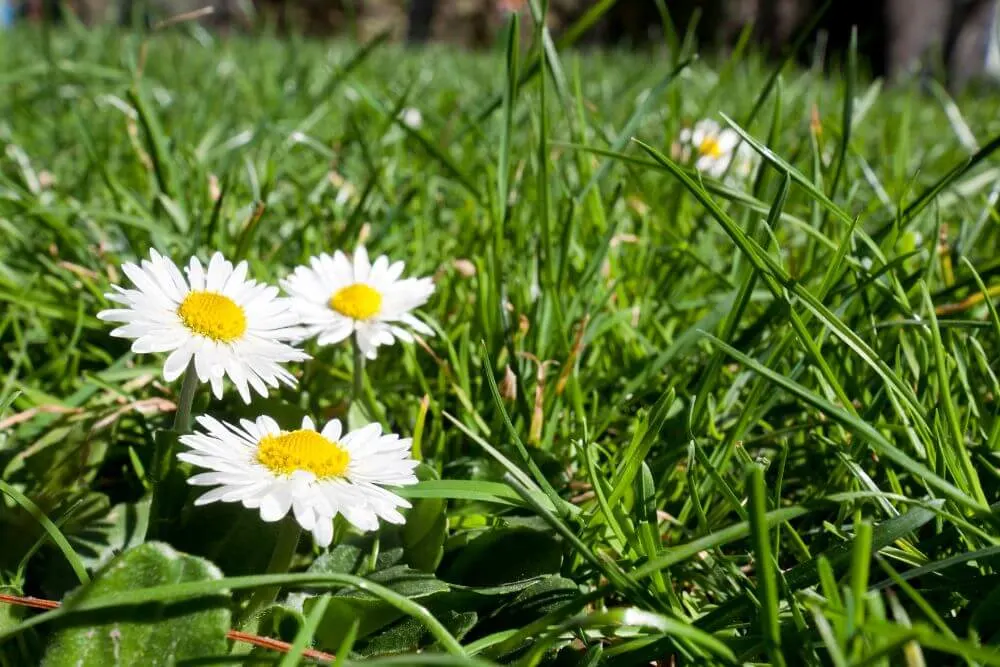
Irish Name: Noínín
Latin Name: Bellis perennis
Family: Asteraceae
One of the flowers that you are bound to see somewhere in Ireland on any given day is the Daisy. This native perennial plant is a common sight in grasslands, parks, lawns and roadsides.
Usually the small flowers with yellow centers are white in color, but they are occasionally tinged with pink on red. Flowers open during the day and close at night. The leaves are spoon shaped and form rosettes at the base of the plant.
Invasive Plants in Ireland
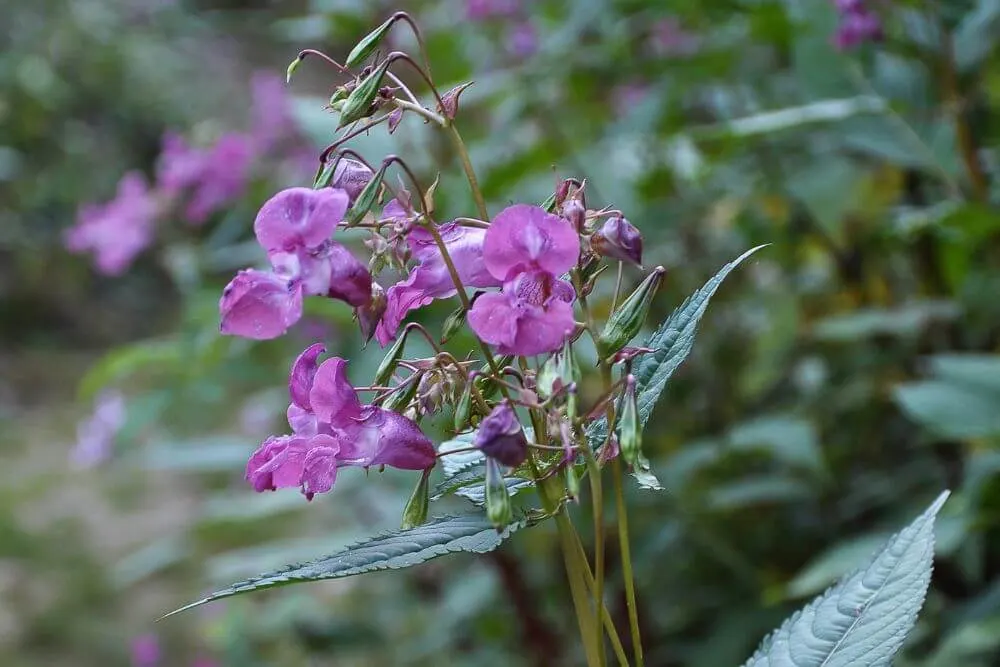
Many plants were (and continue to be) intentionally introduced to Ireland as ornamental garden plants. In some cases, these plants are very well adapted to the climate and soil conditions in this country and “jump the garden fence”. These escaped plants then established their own populations in the wild.
In the absence of their natural pests and predators from their area of origin, some of these plants can thrive to an excessive degree, which negatively impacts other plant and animal species by using resources such as nutrients, light and space that would otherwise be used by native species.
In addition to the two invasive plants mentioned below, Ireland has other problematic invasive plants such as Japanese Knotweed (Reynoutria japonica, syn Fallopia japonica), Himalayan Balsam (Impatiens glandulifera), Nuttall’s Waterweed (Elodea nuttallii), Giant Chilean Rhubarb (Gunnera tinctoria) and Curly Waterweed (Lagarosiphon major) to name just a few that cause problems for Irish plants and trees, as well as wildlife.
Find out more about selecting flowers native to Ireland here. Nothing beats an Irish flower bouquet direct from your own garden either as birthday flowers or as a gift to brighten up your day!
If you are based in Ireland and looking for tips about what native Irish wildflowers seeds to plant in your garden or balcony, check out Invasive Alien Species Ireland or Ireland’s pollinator plan for some inspiration.
Wherever you live, please try to shop for native plants that are beneficial and work better with the local wildlife rather than opting for non-native species that can potentially cause far more harm to the local biodiversity than good.
Rhododendron
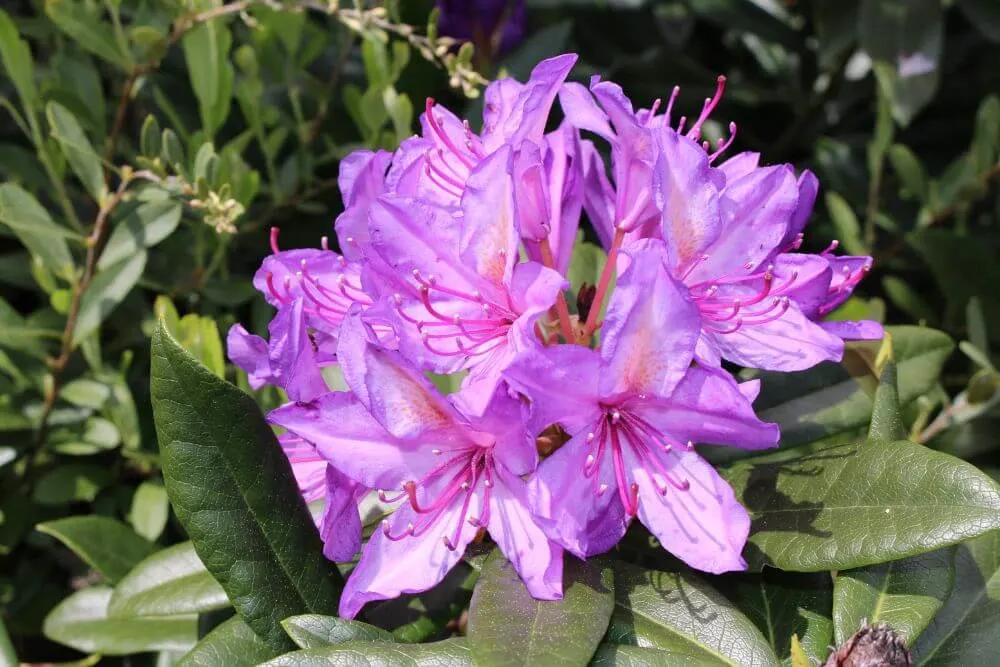
Irish Name: Róslabhras
Latin Name: Rhododendron ponticum
Family: Ericaceae
One of the most problematic invasive species in Ireland is Rhododendron ponticum. This evergreen shrub, which is native to the Black Sea Region and the Iberian Peninsula, can grow up to 5 m in height (ca. 16 ft) and significantly reduces the light resulting in limited tree regenerations and almost eliminates the growth of Irish plants and flowers. It is easy to overlook the impact on Irish moss as well, which can be very detrimental.
Originally this plant was introduced as a garden plant, but it also functions as a windbreak and source of cover for game, such as pheasants. During the month of May, abundant purple flowers blossom with each one having the potential to contain up to 7000 seeds that are light enough for the wind to send in every direction.
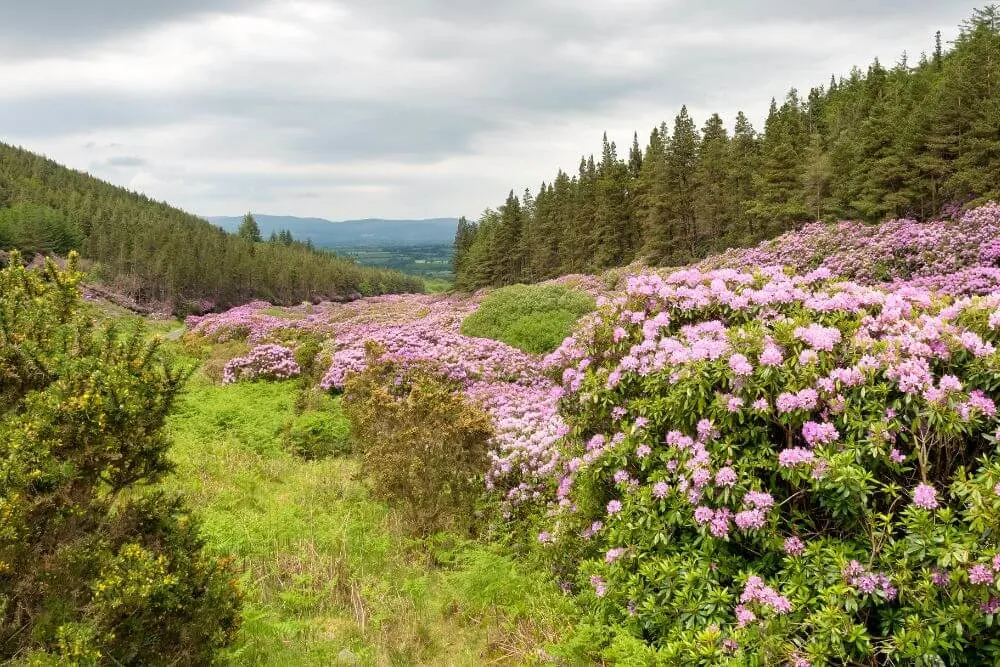
Killarney National Park is a beautiful area in County Kerry, but like many national parks, is not without its own challenges. It is just one area in Ireland where Rhododendron is widespread. The native biodiversity in the area is negatively impacted by the presence of Rhododendron, which outcompetes other native vegetation.
In areas without Rhododendron, overgrazing by sheep and deer also severely hinders the potential for the regeneration of native vegetation, which includes Ireland oak woodlands and Irish yew forest.
Rhododendron eradication programs are costly (Killarney National Park spends several thousand Euros on this task each year) and are extremely time intensive (follow up monitoring is required to remove seedlings).
While Rhododendron blooms are vibrant and colorful, they are short lived, while the ecological impacts that they leave behind are quite devastating.
Giant Hogweed
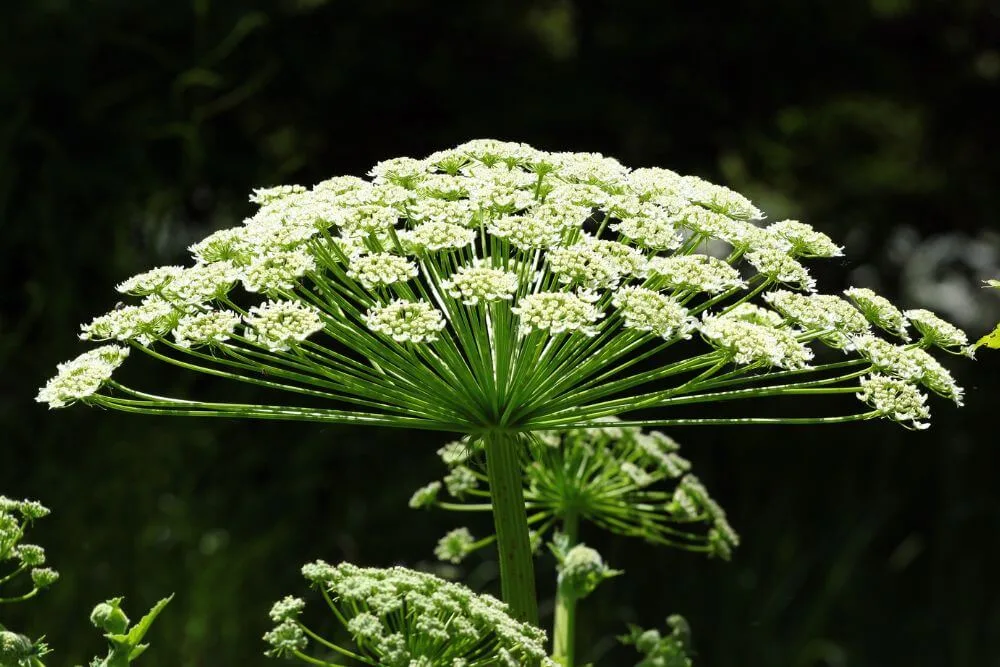
Irish Name: Feabhrán capaill
Latin Name: Heracleum mantegazzianum
Family: Apiaceae
Giant Hogweed as the name suggests is a large plant that can reach heights of up to 5 meters (ca. 16 ft).
This is another non-native plant that was introduced as an ornamental garden plant from the Caucasus region in Victorian times for its impressive size and large umbels (flowers are located in an umbrella-like structure).
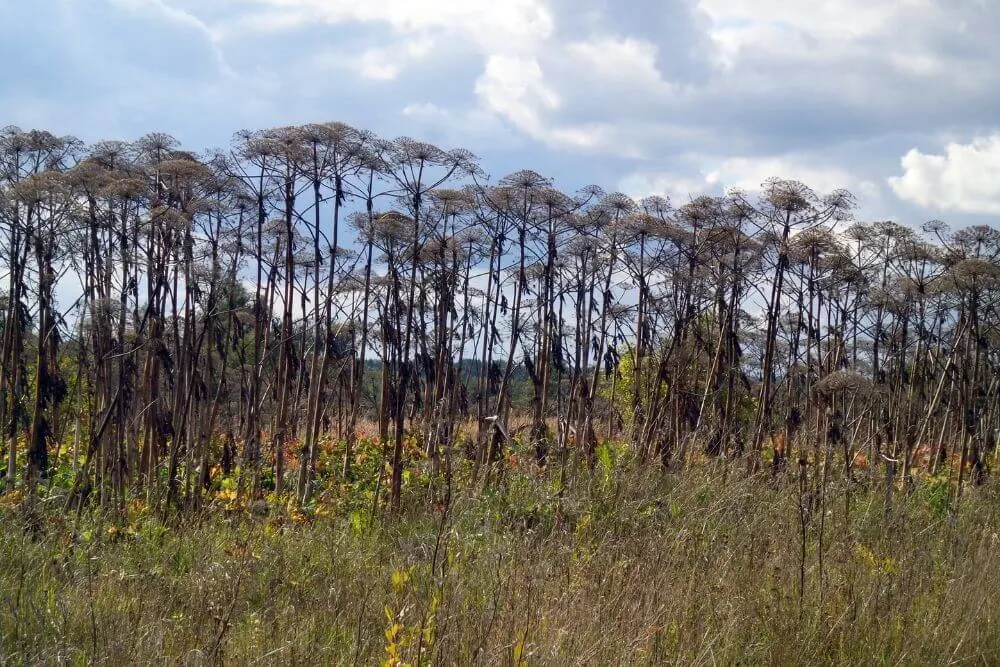
Each plant has the potential to release copious amounts of seed. Once a single plant becomes established in an area, more plants are likely to quickly follow. If the plant is located near a waterway, then many seeds are transported downstream spreading the plant even further.
In addition to threatening native biodiversity, this unwanted introduced species is also highly phytotoxic. The sap of this plant can cause severe and long lasting skin reactions, such as blisters and itching when exposed to sunlight.
It is forbidden to plant this particular species in a garden or in the wild in both Ireland and Northern Ireland.
FAQ
What is Irish for flower?
The word for flower in Irish is bláth (plural bláthanna). This is where the Irish girl’s name of Bláithnaid (meaning “Little Flower” in Irish) comes from.
How do I pronounce the Irish flower names?
The following link will help you learn to get your tongue around how to pronounce the names of the flowers in the Irish language, as well as other Irish words and phrases.
Where to look for other information about Irish wildflowers?
If you are looking for an excellent resource for Irish wildflower identification, then Wildflowers of Ireland is the place to look. Here you will be able to learn about beautiful Irish flowers and meanings by searching for the common name in English, or Irish or the scientific Latin name. It is also possible to search for Irish wildflowers by month, color or family.
The creator of the site, Zoë Devlin, is the author of several books, including The Wildflowers of Ireland – A Field Guide. This is a great book to start with if you want to learn to Identify Irish wildflowers.
What is the Rose of Tralee?
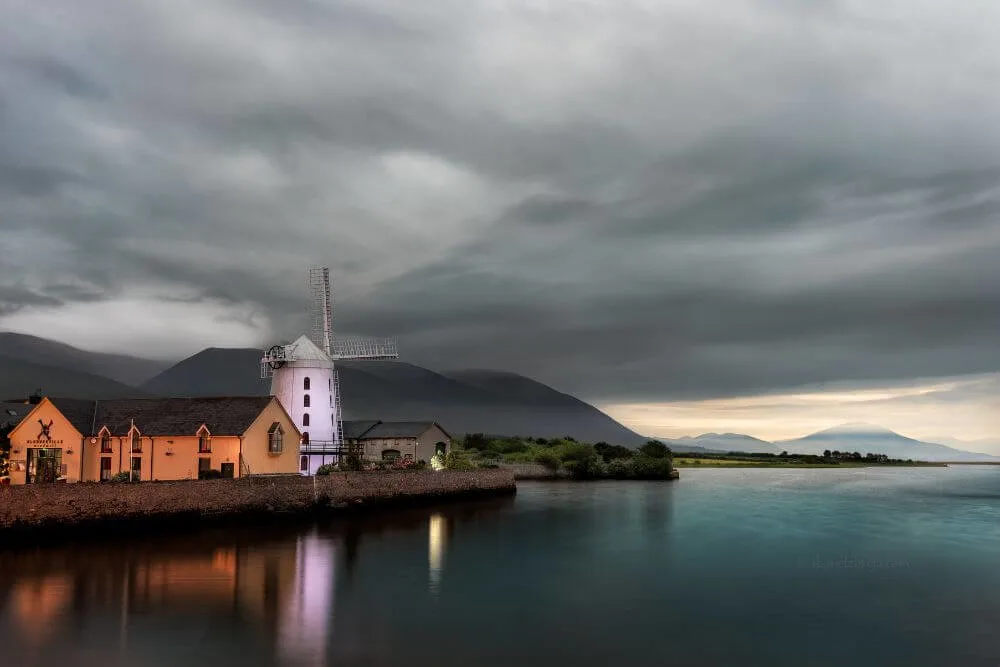
While you might be tempted to think that the Rose of Tralee is an actual flower, it is in fact a long running International Festival that takes place in the town of Tralee, County Kerry each August.
One of the main parts of the festival includes a competition whereby Irish women, or women of Irish descent compete for the coveted crown of the Rose of Tralee.
For some more interesting topics about Ireland, why not check out what Ireland is famous for or some of the most well known Irish symbols.

(Irish Nature Expert and Celtic Enthusiast from Ireland)
Emer Walker, founder of LetsGoIreland.com, is a Cork native with profound expertise in Irish nature and ecology. Holding a PhD in Restoration Ecology and backed by extensive research in ecological sciences, she’s delved deep into Ireland’s natural wonders, from its rugged landscapes to its serene beaches. Emer’s passion also encompasses Celtic art and traditions. As a true authority on Ireland’s natural and cultural heritage, she invites readers through LetsGoIreland.com to immerse themselves in the authentic Irish experience.
